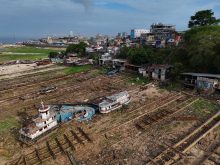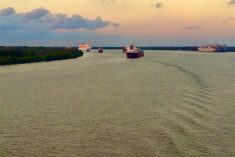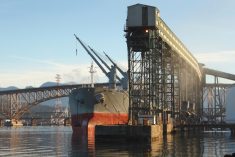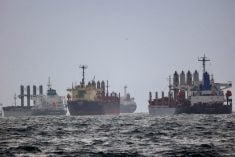Western grain movement to the Port of Vancouver was at 60 per cent of normal as of Dec. 15 and is expected to continually improve, Mark Hemmes, Canada’s grain monitor and president of Quorum Corp. said in an interview Wednesday.
“I think by next week it’s going to look a lot better,” he said. “Is it normal? No. Normal won’t come for another month or two, but certainly better.”
Extensive flooding and landslides caused by record-breaking rainfall last month knocked out road and railway movement in British Columbia’s Interior, halting trains for almost three weeks starting Nov. 15. Vancouver was expecting to receive about 3,400 grain cars during shipping Week 20 (Dec. 13-19), Hemmes said.
Read Also

Pulse Weekly: AAFC raise dry pea, lentil production numbers
Agriculture and Agri-Food Canada raised its 2025/26 production calls for dry peas and lentils from its July report. AAFC issued its latest monthly report on Aug. 20, and adjusted exports, domestic usage and ending stocks.
“Bear in mind a normal week is somewhere between five and six thousand,” he said.
“They did around 670 (grain cars) yesterday (Dec. 14), which is really good when you consider the fact that we went for three weeks with almost none so it is coming back. We’re down to 22 (grain) vessels (waiting in port) this week. You do the math — it means they’re still looking for somewhere around 850,000 tonnes. That translates into 85 trains.”
Why it matters: Most of Western Canada’s grain is exported through the Port of Vancouver and normally the biggest volumes are shipped in the fall and winter. Disruptions can affect farmers’ ability to deliver grain and get paid for it, while grain companies are anxious to fulfill sales and avoid demurrage.
About 25 trains a day — seven of them hauling grain — are now getting to Vancouver, Greg Northey, Pulse Canada’s vice-president of corporate affairs, said in an interview Wednesday.
While grain movement hasn’t returned to normal, that was expected, he added.
“They have been moving a lot of grain through there the last week,” Northey said. “At least on the bulk side we don’t expect things to be ‘normal’ until January. But that’s not to say things aren’t moving.”
One issue the railways have in Vancouver is congestion — a problem under normal conditions given how the port is squished between the ocean, the city and mountains.
Clearing containers will be key, Hemmes said.
“They will be moving those as fast as they can so they can clear the backlog off.” he said. “And that’s going to take awhile because I think this morning there were 13 container ships at the port — 13 container ships and essentially eight berths.
“In order to do that they need to get the container trains in with the container cars. It’s not much different than grain. You need the cars to go in to get the traffic out. But there isn’t an infinite supply of container cars.”
While the railways have moved the grain trains on the way to Vancouver when the flooding occurred, the grain backlog created by the disruption remains, Western Grain Elevator Association executive director Wade Sobkowich said in an interview Wednesday.
“It’s going to take the grain industry weeks and months to clear the shipping backlog,” he said. “We’re probably talking the spring before we can say that we’ve caught up or returned to normal. But I think most grain companies are content with the way the rebound has occurred. They are seeing quicker progress under the extreme circumstances than they probably expected.”
In the meantime grain companies have, at their own expense, been trying to relieve some of the pressure on the rail lines running through B.C., Sobkowich said.
“In some cases they’ve diverted vessels up to Prince Rupert and were able to execute a sale out of that facility,” he said. “In some cases they have ceased forward sales of certain products until 2022 and they’ve re-directed some grain — canola for example destined for the export market to the domestic crush.”
The rail outage will have prevented some Manitoba farmers from delivering grain, but Sobkowich said he doesn’t know to what extent.
“Companies have been trying all they can to take scheduled deliveries,” he said. “In some cases they were not able to take unscheduled deliveries until they had better sense when it would move, but now that things are moving again I am sure that producers are being contacted and invited to deliver.”
Much of Manitoba’s grain moves through Thunder Bay until the annual freeze-up on the Great Lakes-St Lawrence Seaway system. The Montreal-to-Lake Ontario stretch of the seaway is set to close for the 2021 season on Dec. 31.
Some Manitoba grain also moves south to the U.S.
Prairie elevators took 4.41 million tonnes of grain in from farmers during Week 18 (Nov. 28 to Dec. 4), according to the Grain Monitor’s Week 18 report. Eighty-one per cent of the Prairie elevator system was being used.
“Space in primary elevators is good,” the report said.
Total western port terminal stocks decreased to 1.09 million tonnes in Week 18, utilizing 56 per cent of the working capacity.
On the export side year-to-date, western Canadian shipments from port terminal elevators as of Week 18 were 37 per cent lower than the same period last year and 22 per cent lower than the three-year average.
While the WGEA has sometimes been critical of rail service, it’s not complaining now given how quickly the railways restored service.
Both Hemmes and Northey are impressed, too.
“I’ve said it before and I will say it again, it’s a testament to how good the railways’ engineering departments are,” Hemmes said. “They managed to take a roll of duct tape and binder twine and turn it into gold.
“They did a phenomenal job and in what you’d think would be the (worst) place to be in the last two weeks, somewhere between Kamloops and Vancouver, because you are ploughing around in the rain and the muck trying to rebuild a railway and you have to do it fast.”
Northey, an engineer by training, said what the railways did would’ve made a fascinating reality TV show.
“The feat of engineering that was pulled off, especially for CP to get their line up and going in six days or less, was really incredible,” he said.
“How they managed to do that, how they are going to get the Coquihalla (highway) up and running in the few weeks is just amazing.”
— Allan Dawson is a reporter for the Manitoba Co-operator at Miami, Man.
















